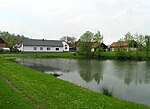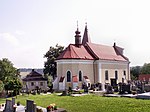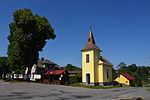Sedletín
Villages in Havlíčkův Brod DistrictVysočina Region geography stubs

Sedletín is a municipality and village in Havlíčkův Brod District in the Vysočina Region of the Czech Republic. It has about 300 inhabitants. Sedletín lies approximately 13 kilometres (8 mi) north of Havlíčkův Brod, 36 km (22 mi) north of Jihlava, and 92 km (57 mi) south-east of Prague.
Excerpt from the Wikipedia article Sedletín (License: CC BY-SA 3.0, Authors, Images).Sedletín
okres Havlíčkův Brod
Geographical coordinates (GPS) Address Nearby Places Show on map
Geographical coordinates (GPS)
| Latitude | Longitude |
|---|---|
| N 49.708611111111 ° | E 15.564444444444 ° |
Address
29
583 01 okres Havlíčkův Brod, Sedletín
Southeast, Czechia
Open on Google Maps











